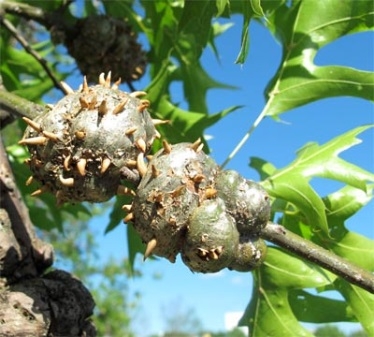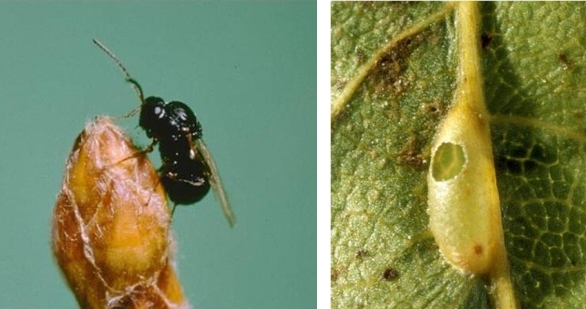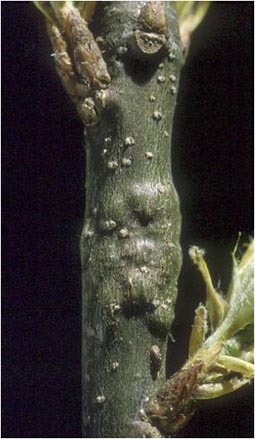Horned Oak Gall
ENTFACT-457: Horned Oak Gall | Download PDF
By Lee Townsend, Extension Entomologist and
Daniel Potter, Horticultural Entomologist
University of Kentucky College of Agriculture

Fig. 1 Horned oak galls
Horned oak galls are unsightly, golf ball-size woody growths on oak twigs caused by a tiny wasp (Callirhytis comigera). The name refers to the characteristic horns that protrude from the surface of the mature galls.
Lightly infested pin oaks can live for many years without apparent harm but outbreak infestations can disfigure trees causing extensive branch dieback and even tree death. The clusters of dried out galls, which are especially noticeable after autumn leaf fall, remain aesthetically disfiguring for years after the wasps have emerged and abandoned them. The gouty oak gall, which is similar but lacks the horns, is produced by the wasp C. quercuspunctata. The complex life cycle of these wasps thwarts control efforts.
Life Cycle
Large numbers of female wasps emerge from the mature woody galls in late March through mid-April. Each wasp uses a horn as its escape tunnel, chewing an exit hole through the end. Those females place tiny eggs into swelling leaf buds.

Fig. 2 Female gall wasp placing eggs in bud for leaf gall generation
Fig. 3 Leaf gall with emergence hole of wasp
Each leaf gall, which resembles a tiny, inconspicuous blister on the underside of leaves along mid- or lateral vein, contains a white grub-like larva. Those grubs mature into male and female wasps that exit the leaf galls from late May through early June. After mating, females insert eggs in a spiral arrangement around 1- or 2-year old twigs to start the twig gall generation.

Fig. 4 Slight swellings of an 11-month old twig gall.
Twig galls appear as slight swellings about 10 months after egg hatch. They, too, contain small, white larvae. Irregular tissue growth continues and individual swellings combine to form large, irregular woody galls with individual chambers for each developing larva.
Galls increase in size for about 24 months and may house as many as 160 developing wasps. The hollow horns begin to project from galls that are about 2 years old and ultimately serve as escape tunnels. Galls harden and dry after their residents leave and the horns break off. The stem gall generation takes about 33 months from egg hatch to adult emergence. These females move to leaf buds to lay eggs for the leaf gall generation.
Consecutive generations of horned oak gall wasps alternate between developing in small blister-like leaf galls and large, communal, woody twig galls.
No clear management options
Management approaches for the horned oak gall on landscape pin and willow oaks continue to be evaluated but no easy solution has been found.
Canopy sprays in early spring to kill the wasps before they lay eggs in the swelling buds, or sprays in late spring to kill wasps emerging from the leaf galls may provide partial control. Spraying tall trees is impractical in most settings and also kills natural enemies that help keep other pests, such as scale insects, in check. Trunk injections of systemic neonicotinoid insecticides have not proven effective for reducing numbers of leaf galls.
Some professional arborists report that injecting trees with bidrin (a Restricted Use Pesticide) in spring for four consecutive years is suppressing horned oak gall infestations. That approach, which targets the seemingly more vulnerable leaf gall stage, has not yet been scientifically evaluated.
Success is difficult to evaluate because dead twig galls will remain for several years. Infested trees have twig galls in several stages of development, maturation of which takes almost 3 years. Therefore, a single insecticide application does not end an infestation.
If a few woody galls are noticed, it pays to promptly remove them if they can be reached with a pole pruner. However, this is not practical in mature tall trees. Beneficial insects, including several species of parasitic wasps, help to suppress horned oak gall populations on many trees. Individual trees vary in resistance or susceptibility; often some are heavily infested while others nearby are nearly gall-free. The basis for such resistance is unknown.
Sources:
- Eliason EA and DA Potter. 2000. Biology of Callirhytis cornigera (Hymenoptera: Cynipidae) and the arthropod community inhabiting its galls. Environ Ent 29: 551-559
- Eliason EA and DA Potter. 2000. Impact of whole-canopy and systemic insecticidal treatments on Callirhytis cornigera (Hymenoptera: Cynipidae) and associated parasitoids on pin oak. J Econ Ent 93: 165-171.
- Eliason, EA and DA Potter. 2001. Biology and management of the horned oak gall wasp on pin oak. J Arboriculture 27: 92-100.
7/2014
CAUTION! Pesticide recommendations in this publication are registered for use in Kentucky, USA ONLY! The use of some products may not be legal in your state or country. Please check with your local county agent or regulatory official before using any pesticide mentioned in this publication.
Of course, ALWAYS READ AND FOLLOW LABEL DIRECTIONS FOR SAFE USE OF ANY PESTICIDE!
Images: University of Kentucky College of Agriculture
